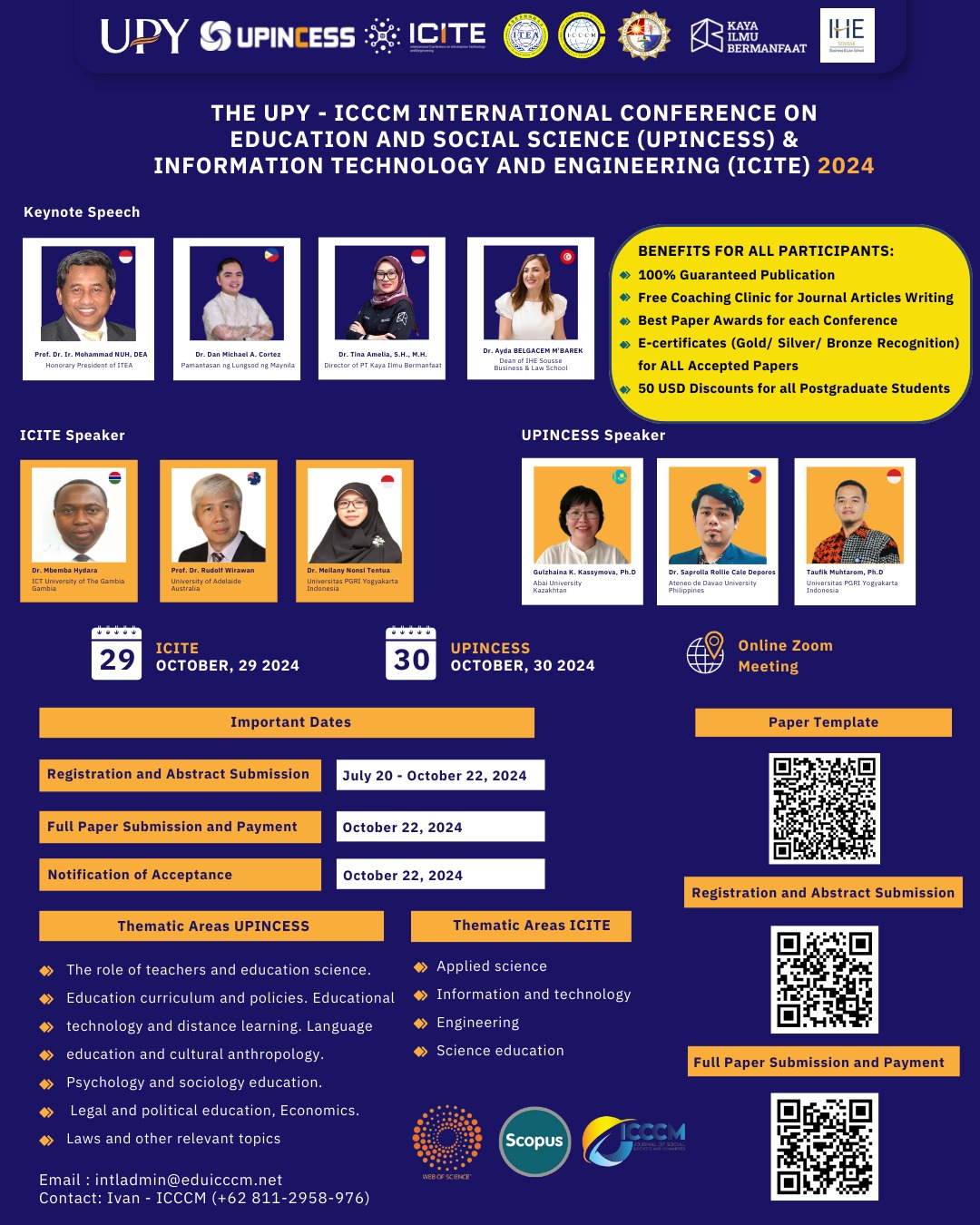A Survey on Problems of Dyscalculia in Primary Schools
DOI:
https://doi.org/10.53797/icccmjssh.v1i2.4.2022Keywords:
dyscalculia., Mathematics, learning diffficulties, education, primary schoolAbstract
Dyscalculia is a learning difficulty faced by an individual. The purpose of this study is to investigate the level of problems of dyscalculia in primary schools. The researchers employed quantitative design to carry out the study. Survey method is used to collect the data. Descriptive and inferential statistics are used to analyse the survey data. A study was conducted with 381 primary schools Mathematics teachers in Malaysia. Means and standard deviation were used to analyse the level of problems of dyscalculia, whereas independent t-test were used to compare the level of problems of dyscalculia between school locations. The results show that the level of problems of dyscalculia is medium high (M=3.31, σ=0.97). On the other hand, the problem of dyscalculia in rural area is slightly higher (M=3.822, σ=0.697) than the urban area (M=3.717, σ=0.696). In short, there is no significant difference for the level of problems of dyscalculia between different school locations (p=0.147, p>0.05). This study is able to bring significances to Ministry of Education Malaysia, educators, teachers, and researchers. The result is useful to determine the allocations of funding and resources for the students with learning difficulties. It is also able to create the awareness of dyscalculia among the people. As a conclusion, interventions and diagnosis need to be carried out in order to improve the capabilities of these pupils to the maximum.
Downloads
References
Ahmad, N. A., & May, Y. S. (2018). Challenges in Preparing Teachers for Inclusive Education and Its Impact to Students with Learning Disabilities. International Journal of Academic Research in Progressive Education and Development, 7(3). https://doi.org/10.6007/ijarped/v7-i3/4575
Ahmad, N.A., & Khoo, Y.Y. (2019). Using interactive media to support reading skills among underachieving children. International Journal of Innovation, Creativity and Change, 8(7), 81-88.
Aquil, M.A.I., & Ariffin, M.M. (2020). Dyscalculia, causes, interventions and Malaysian Scenario. Hamdard Islamic, 43(2), 960-971.
Bird, R. (2017). The Dyscalculia Toolkit: Supporting Learning Difficulties in Maths Third Edition. Sage Publications Ltd.
Chinn, S. (2019). Maths Learning Difficulties, Dyslexia, and Dyscalculia (2nd ed.). Jessica Kingsley Publishers.
Chinn, S. (2020). Math Trouble with Maths: A Complete Manual to Identifying and Diagnosing Mathematical Difficulties (3rd ed.). Taylor & Francis Ltd.
Dessemontet, R. S., Opitz, E. M., & Schnepel, S. (2019). The Profiles and Patterns of Progress in Numerical Skills of Elementary School Students with Mild and Moderate Intellectual Disability. International Journal of Disability Development and Education, 67(4), 409–423. https://doi.org/10.1080/1034912x.2019.1608915
Filippello, P., Buzzai, C., Messina, G., Mafodda, A. V., & Sorrenti, L. (2019). School Refusal in Students with Low Academic Performances and Specific Learning Disorder. The Role of Self-Esteem and Perceived Parental Psychological Control. International Journal of Disability Development and Education, 67(6), 592–607. https://doi.org/10.1080/1034912x.2019.1626006
Fu, S. H., & Chin, K. E. (2017). An Online Survey Research Regarding Awareness of Dyscalculia among Educators in Sandakan District, Sabah. International Journal of Academic Research in Progressive Education and Development, 6(2). https://doi.org/10.6007/ijarped/v6-i2/2891
Khing, B. (2016). Dyscalculia: its types, symptoms, causal factors, and remedial programmes. Learning Community, 7(3), 217-229.
Low, H.M., Lee, L.W., & Ahmad, A.Z. (2019). Knowledge and attitudes of special education teachers towards the inclusion of students with autism spectrum disorder, International Journal of Disability, Development and Education, 67(5), 497-514.
Meral, B.F., & Turnbull, H.R. (2014). Analysis of special education policy in Turkey and United States: improving Turkey’s Policy for students with intellectual disability. Journal of Policy and Practice in Intellectual Disabilities, 11(3), 165-175.
Omar, M., & Ali, D.F. (2019). A review of vocational education for students with special needs. Technical and Vocational Education Malaysia Journal, 8, 58-65.
Pallant, J. (2010). SPSS survival manual: a step by step guide to data analysis using SPSS. England, UK: McGraw-Hill International Edition.
Santos, F.H.D., Silvam P.A.D., Ribeiro, F.S., Dias, A.L.R.P.D., Frigerio, M.C., Dellatolas, G., & von Aster, M. (2012). Number processing and calculation in Brazilian children aged 7-12 years. The Spanish Journal of Psychology, 15(2), 513-525.
Shyielathy, A., Kway, E.H. & Zainiah @ Zaniah Mohamed Isa. (2019). Developing Symtomatic Behavior Screening Tool (SymBest) for children with behaviour problems: a fuzzy delphi method. Malaysia Journal of Social Sciences and Humanities (MJSSH), 3(2), 141-171.
Soltani, A., & Mirhosseini, S. (2019). The Contribution of General Cognitive Abilities and Specific Number Skills toward Arithmetic Performance in Students with Mild Intellectual Disability. International Journal of Disability Development and Education, 67(5), 547–562. https://doi.org/10.1080/1034912x.2019.1619673
Sousa, P., Dias, P.C. & Cadime, I. (2016). Predictors of primary school teachers’
knowledge about developmental dyscalculia. European Journal of Special Needs Education, 2(1), 3-10.
Wong, K.K., Pang, V., Chin, K.E. & Tan, C.K. (2014). Prevalence rate of dyscalculia according to gender and school location in Sabah, Malaysia. 7th International Conference on University Learning and Teaching (InCULT 2014) Proceedings, 91-100.
Wong, K.K., Pang, V.A., Chin, K.E., & Tan, C.K. (2016). Prevalence rate of dyscalculia according to gender and school location in Sabah, Malaysia. In Chan, Y.F., Sidhu, G.K., Narasuman, S., Lee, L.F., & Rahman, S.B.A. (Eds.), 7th International Conference on University Learning and Teaching (InCULT 2014) Proceedings (pp. 91-100). Springer.
Yoong, S.M. (2020). An introduction: what do you know about dyscalculia? In Habidin, N.F., Yong, S.Y.O., Chik, T.W.T. & Muhamad, U.A. (Eds.), The Revolution in Social Research and Education (pp. 82-88). Kaizentrenovation Sdn Bhd.
Yoong, S.M,. & Ahmad, N.A. (2018). A conceptual framework for DoCtor WoRM’s Module in improving multiplication skills among Year Four low achievers. International Journal of Academic Research in Business and Social Sciences, 8(4), 946-957.
Yoong, S.M., & Ahmad, N.A. (2020a). A conceptual framework to design and develop dyscalculia checklist instrument for dyscalculic students. Solid State Technology, 63(1s), 495-501.
Yoong, S.M., & Ahmad, N.A. (2020b). The needs and significance to design and develop a Dyscalculia checklist. Malaysian Science & Mathematics Education Journal, 10(2), 8-14.
Downloads
Published
How to Cite
Issue
Section
License
Copyright (c) 2022 Soo May Yoong, Sukor Beram, Kumaran Gengatharan, Azlina Amat Yasin

This work is licensed under a Creative Commons Attribution-NonCommercial-ShareAlike 4.0 International License.




